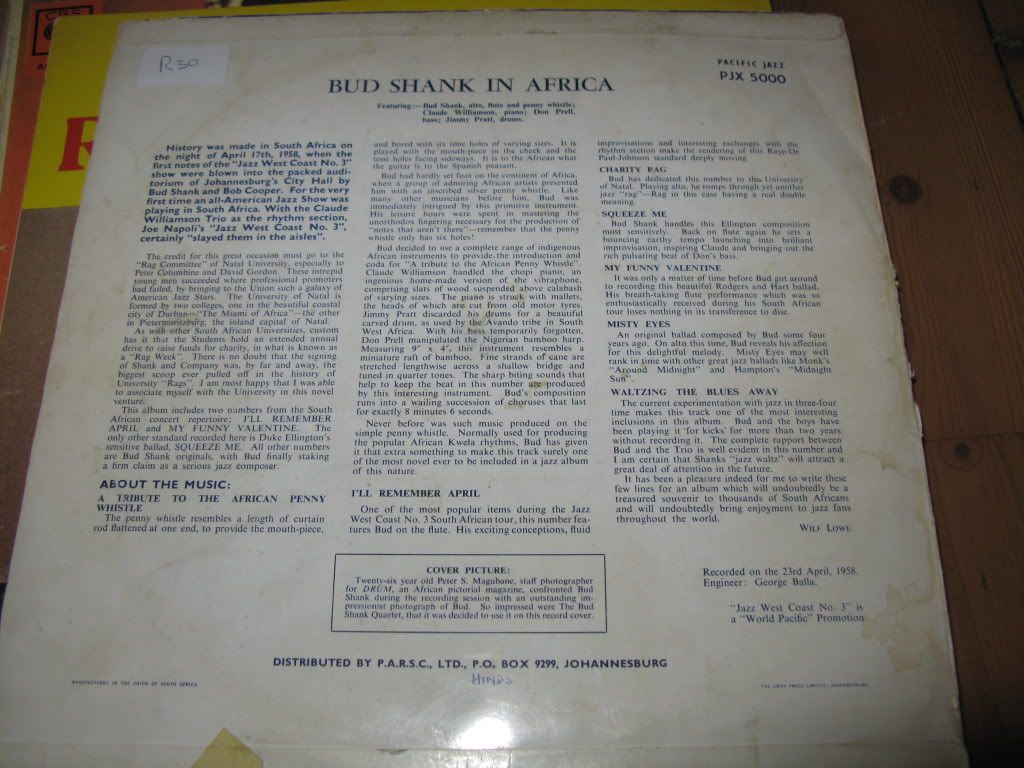So I'm in Kalk Bay in the Cape. And I peel off from my wife and kids and look in an antique shop.
On the top of a rather tired looking chest of drawers are some records. Only 40 Rand each the tired looking lady at the counter tells me. I smile and after flicking through some 80s chuff I chance upon this.
At first I think about leaving it. I mean, its by Bud Shank! But then I notice that the cover says that its 'By Arrangement With the University of Natal'. Now that's interesting.
So I look at the back cover and what does it say? Well for once the back cover is very informative. It would appear that the Rag Committee of the University of Natal was somehow able to get Shank, who in 1958, the year of the tour and this recording, was already something of a star on the West Coast of America.to play a series of gigs in Johannesburg.
Shank played in Johannesburg alongside a number of other US musicians. Interestingly one of them was Claude Williamson who later recorded with Spokes Mashiyane.
Shank was a central figure of the West Coast cool jazz scene but prior to that had played in a number of big bands, most notably that of Stan Kenton. In many ways it was the big band sound that was still influential on the South African jazz scene - particularly bands such as the Harlem Swingsters and the Jazz Maniacs and the kwela sound - perhaps explaining Williamson and Mashiyane.
For the most part this record is very pleasant cool jazz. Shank is a fine player, equally at home on sax as flute. But of most interest is 'A Tribute to the African Penny Whistle'. As the sleeve notes explain:
"The penny whistle resembles a length of curtain rod flattened at one end to provide the mouth-piece, and bored with six tome holes of varying sizes. It is played with the mouth-piece in the cheek and the tone holes facing sideways. It is to the African what the guitar is to the Spanish peasant.
Bud had hardly set foot on the continent of Africa, when a group of admiring African artists presented him with an inscribed silver penny whistle. like many other musicians before him Bud was immediately intrigued by this primitive instrument. his leisure hours were spent in mastering the unorthodox fingering necessary for the production of 'notes that aren't there' - remember that the penny whistle only has six holes!
Bud decided to use a complete range of indigenous African instruments to provide the introduction and coda for 'A tribute to the African Penny Whistle'. Claude Williamson handled the chopi piano, and ingenious home-made version of the vibraphone, comprising slats of wood suspended above calabash of varying sizes. The piano is struck with mallets the heads of which are cut from old tyres. Jimmy Pratt discarded his drums for a beautiful carved drum as used by the Avando tribe in South West Africa. With his bass temporarily forgotten, Don Prell manipulated the Nigerian bamboo harp. Measuring 9" x 4",this instrument resembles a miniature raft of bamboo. Fine strands of cane are stretched lengthwise across a shallow bridge and tuned in quarter tones. The sharp biting sounds that help to keep the beat in this number are produced by this interesting instrument. Bud's composition runs into a wailing succession of choruses that last for exactly 8 minutes 6 seconds.
Never before was such music produced on the simple penny whistle. Normally used for producing the popular African Kwela rhythms, Bud has given it that extra something to make this track surely one of the most novel ever to be included in a jazz album of this nature."
Lets ignore the racist and disdainful treatment of South African musician when compared to white American ones. I don't think we can be surprised by the tone of the sleeve notes.
In the hands of a West Coast jazz musician kwela takes on a distinctly exotic air. To my ears it sits in the realm of Martin Denny and Les Baxter rather than in the world of jazz. Interestingly Shank would go on to record albums of bossa nova and Williamson would take a Latin jazz turn. Obviously both men were open to music from other parts of the world. In the case of kwela and bossa these were musics that had been influenced by the sounds of big bands such as that of Stan Kenton, with whom both me played. I like that kind of circularity.
In my view, this is a small example of what might had happened with South African jazz. On the back of the popularity of kwela in the UK, of the appropriation of South African songs by American and British jazz musicians (Tom Hark, Wimoweh/Mbube, Skokiaan etc) it is not inconceivable that South African jazz could have been brought into the pop mainstream of Europe and America in the way that bossa nova was to be. Whether this would have changed the lives of many South African musicians is debatable - but it might have meant that exile was not the only way to reach audiences outside of the country.
However, as the apharteid juggernaut continued, this version of events proved impossible. Musicians such as Shank would refuse to play in South Africa and kwela, and South African jazz would remain a minority interest outside of the country.
An intriguing and unusual recording.


Where's the rip?
ReplyDeleteCan't find it...
No rip
ReplyDeleteJust words
Will put something up later in the week
Here's his Tribute to the African Pennywhistle
ReplyDeletehttp://www.divshare.com/download/8075675-cce
Let me know if it works - not done this before